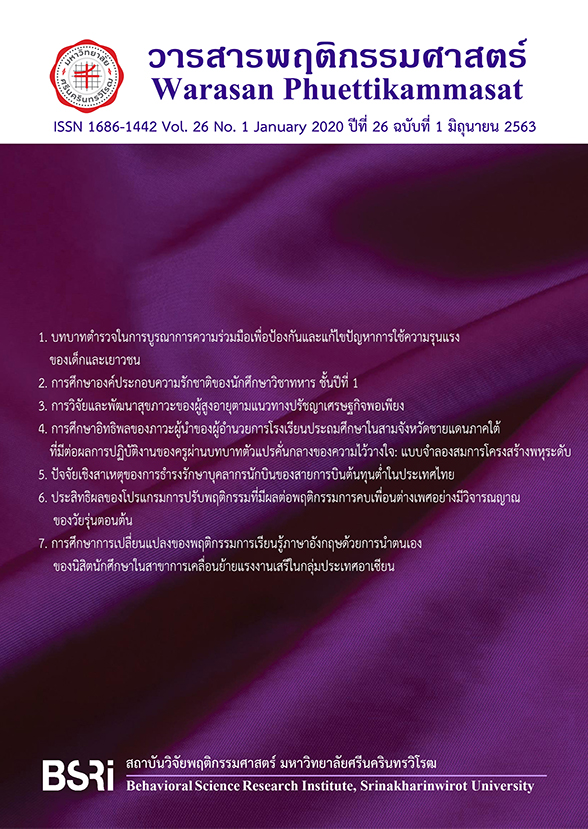บทบาทตำรวจในการบูรณาการความร่วมมือ เพื่อป้องกันและแก้ไขปัญหาการใช้ความรุนแรงของเด็กและเยาวชน
Keywords:
Police role, Violence, Child and YouthAbstract
การวิจัยครั้งนี้มีวัตถุประสงค์เพื่อทำความเข้าใจและอธิบายปรากฏการณ์การใช้ความรุนแรงของเด็กและเยาวชนไทย จากการถอดบทเรียนประสบการณ์เจ้าหน้าที่ตำรวจและทีมสหวิชาชีพ และจากมุมมองของศาสตร์ต่างๆ รวมถึงเพื่อค้นหาแนวทางพัฒนาบทบาทตำรวจในการบูรณาการความร่วมมือเพื่อการป้องกันและแก้ไขปัญหาการใช้ความรุนแรงของเด็กและเยาวชน ใช้ระเบียบวิธีวิจัยเชิงคุณภาพ (Qualitative research) ทำการเก็บรวบรวมข้อมูลโดยใช้การสัมภาษณ์เชิงลึก (In-depth-interview) การเขียนเล่าเรื่อง (Story telling) และการสนทนากลุ่ม (Focus group) โดยกลุ่มผู้ให้ข้อมูลสำคัญ (Key informant) ได้แก่ กลุ่มข้าราชการตำรวจและพนักงานสอบสวน ทีมสหวิชาชีพที่ร่วมสอบสวนคดีเด็กและเยาวชน กลุ่มผู้ทรงคุณวุฒิ ผู้เชี่ยวชาญ และนักวิชาการในศาสตร์สาขาวิชาต่างๆ
ผลการศึกษาวิจัย พบว่า สถานการณ์การใช้ความรุนแรงของเด็กและเยาวชน มีข้อค้นพบ 8 ประเด็นได้แก่ (1) เด็กและเยาวชนที่ใช้ความรุนแรงมีอายุน้อยลง (2) เด็กเลียนแบบความรุนแรงจากสื่อทั้งต่อผู้อื่นและต่อตนเอง (3) พฤติกรรมรุนแรงอันตรายมากขึ้น และใช้ความรุนแรงได้ง่ายขึ้น (4) มีการขยายพื้นที่ความรุนแรงไปสู่สังคมออนไลน์ (5) กลุ่มแก๊งความรุนแรงกลายเป็นเรื่องปกติ เปิดเผยได้ (6) การสร้างความเกลียดชังกันทำได้ง่ายขึ้น และ (7) การใช้ความรุนแรงมีลักษณะที่ซับซ้อนขึ้นและขยายขอบเขตความรุนแรงได้ง่าย และ (8) เหยื่อที่เป็นตัวเร้าให้กระทำรุนแรงแปรเปลี่ยนไป ในส่วนปัจจัยหรือเงื่อนไขที่เกี่ยวข้องกับการใช้ความรุนแรงของเด็กและเยาวชน แบ่งออกเป็น 7 มิติได้แก่ (1) ด้านตัวตนของเด็กและเยาวชน (2) ด้านครอบครัว (3) ด้านเพื่อน (4) ด้านสถานศึกษา (6) ด้านชุมชน และ (7) ด้านระบบการศึกษา/สังคม/เศรษฐกิจ ส่วนแนวทางในการพัฒนาบทบาทตำรวจในการบูรณาการความร่วมมือเพื่อการป้องกันและแก้ไขปัญหานั้น ในส่วนของการพัฒนาบทบาทตำรวจ ควรทำการพัฒนาใน 4 ประเด็นหลัก ได้แก่ (1) การพัฒนาบทบาทในการปฏิบัติหน้าที่ (2) การพัฒนาคุณลักษณะส่วนบุคคล (3) การพัฒนาด้านการศึกษาและฝึกอบรม และ (4) การพัฒนาระบบบริหารจัดการงานตำรวจ โดยต้องพัฒนาควบคู่ไปกับการสร้างและพัฒนาเครือข่ายความร่วมมือจากทุกภาคส่วนและการสร้างความต่อเนื่องและยั่งยืนของเครือข่าย
Downloads
References
คณะกรรมการส่งเสริมการพัฒนาเด็กและเยาวชนแห่งชาติ. (2560). แผนพัฒนาเด็กและเยาวชนแห่งชาติ ฉบับที่ 2 (พ.ศ.2560-2564). สืบค้นจาก https://tpso4.m-society.go.th/index.php/th/tpso-news/.
จรวยพร ธรณินทร์. (2550). การสร้างความเข้มแข็งในการบริหารจัดการแบบเครือข่าย. สืบค้นวันที่ 20 พฤศจิกายน 2561 จาก https://www.google.com/search?ei=XkEBXKe2HpP99QPaioS4 Cg&q.
จินตวีร์ เกษมศุข. (2554). การสื่อสารกับการเปลี่ยนแปลงของสังคม. กรุงเทพฯ : จุฬาลงกรณ์ มหาวิทยาลัย.
จิราภา เต็งไตรัตน์และคณะ (2554). การเรียนรู้. ในจิราภา เต็งไตรรัตน์ และคณะ, จิตวิทยาทั่วไป (พิมพ์
ครั้งที่ 7, หน้า 121-153). กรุงเทพฯ : มหาวิทยาลัยธรรมศาสตร์.
นัทธี จิตสว่าง. (2539). อาชญาวิทยาและทัณฑวิทยา. นนทบุรี: สานักพิมพ์มหาวิทยาลัยสุโขทัยธรรมาธิราช.
สมร บรรยงค์ และ ปิยาภรณ์ ศิริภานุมาศ (2555). การจัดระเบียบสังคมด้านพฤติกรรมรุนแรงของเยาวชนตำบลทองหลาง อำเภอบ้านใหม่ไชยพจน์ จังหวัดบุรีรัมย์. วารสารวิจัยและพัฒนา มหาวิทยาลัย ราชภัฏบุรีรัมย์. 7 (2), 80-88.
เสกสัณ เครือคำ. (2558). อาชญากรรม อาชญาวิทยา และงานยุติธรรมทางอาญา. นครปฐม : เพชรเกษมการพิมพ์.
เสริณ ปุณณะหิตานนท์. (2558). การกระทำผิดในสังคม สังคมวิทยาอาชญากรรมและพฤติกรรมเบี่ยงเบน. กรุงเทพฯ : สำนักพิมพ์แห่งจุฬาลงกรณ์มหาวิทยาลัย.
สุวรรณา เรืองกาญจนเศรษฐ์ และคณะ (2552). พฤติกรรมเสี่ยงในเด็กและเยาวชนในกรุงเทพมหานคร.(วิทยานิพนธ์ปริญญาสังคมสงเคราะห์ศาสตร์มหาบัณฑิต) มหาวิทยาลัยธรรมศาสตร์. กรุงเทพมหานคร.
สำนักงานคณะกรรมการพัฒนาเศรษฐกิจและสังคมแห่งชาติ. (2559). แผนพัฒนาเศรษฐกิจและสังคมแห่งชาติ ฉบับที่ 12 (พ.ศ.2560-2564). สืบค้นจาก https://www.nesdb.go.th.
สำนักวิจัยเอแบคโพลล์. (2552). วัยรุ่นไทยกับการใช้ความรุนแรง. [online]. สืบค้นจาก https://www. clinicdek.com/index.php?option=com_content&task=view&id=632
ศิริไชย หงส์สงวนศรี และนิดา ลิ้มสุวรรณ. (2558). พัฒนาการทางจิตใจ. ใน มาโนช หล่อตระกูล และปราโมทย์ สุคนิชย์ (บรรณาธิการ), จิตเวชศาสตร์ รามาธิบดี. (ครั้งที่ 4). (น.1-27). กรุงเทพฯ : ภาควิชาจิตเวชศาสตร์ คณะแพทย์ศาสตร์โรงพยาบาลรามาธิบดี มหาวิทยาลัยมหิดล.
ศรีเรือน แก้วกังวาล. (2561). ทฤษฎีจิตวิทยาบุคลิกภาพ. (พิมพ์ครั้งที่ 17). กรุงเทพฯ : สำนักพิมพ์หมอชาวบ้าน จำกัด.
Bandura, A. (1986). Social Foundations of thought and action : A social cognitive theory. Englewood Cliffs, NJ : Prentice Hall.
Cohen, A. K. (1955). Delinquent Boys. The Culture of the Gang. Glencoe, Illinois : The Free Press.
Craig, A. A. (2012). The Influence of Media Violence on Youth. Psychological Science in the Public Interest December 2003 vol. 4 no. 381-110.
Elliott, S. D. (2008). Youth Violence: An Overview. New York: Center for The Study and Prevention of Violence.
Fortinash, K. M. & Patricia, A. H. (2008). Psychiatric Mental Health Nursing. Canada : Mosby.
Kail, R. V. & Cavanaugh, J. C. (2010). The Study of Human Development. Human Development : A Life-span View. (5th ed.). Belmont, CA: Wadsworth Cengage Learning.
Passer, M.A. & Smith, R.E. (2011). Psychology : The Science of Mind and Behavior. (5th ed.). New York, NY : McGraw-Hill.
Reid, S. T. (1997). Crime and Criminology. (8th ed.). New York : Brown & Benchmark Publishers.
Santrock, J. W. (2007). A Topical Approach to Life-Span Development. New York : McGraw-Hill.
Schaefer, R. T. & Lamn, R. P. (1998). Sociology : Instructor’s Manual. (pp. 96-97). New York : The McGraw-Hill Companies. Inc.
Stuart G.W. (2009). Principles and practice of psychiatric nursing. (9th ed.). St. Louis: Mosby Inc.
UNICEF. (2010). Understanding Media: The Extensions of Man, 1st ed. New York : McGraw-Hill.
Translated Thai References (ส่วนที่แปลรายการอ้างอิงภาษาไทย)
ABAC Poll Research Center. (2009). Thai Teenagers and Violence. [online]. searched from http: //www. clinicdek.com/index.php?option=com_content&task=view&id=632.
Charuayporn Toranin. (2007). Strengthening Network Management. searched on 20 November 2018 from https://www.google.com/search?ei=XkEBXKe2HpP99QPaioS4Cg &q.
Chintawee Kasemsuk. (2011). Communication and Social Change. Bangkok: Chulalongkorn University. Jirapa Tengtirat, et al. (2011). Learning. In Jirapa Tengtirat, et al. General Psychology (Type No. 7, Page 121-153). Bangkok: Thammasat University.
Department of Juvenile Observation and Protection. (2018). Survey of the Number of Juvenile Offenders. Bangkok: Academic Center, Health Promotion Fund.
Nathee Jitsawang. (1996). Criminology and Penology. Nonthaburi: Sukhothai Thammathirat Open University Press Office.
National Children and Youth Development Committee. (2017). National Child and Youth Development Plan No. 2 (2017-2021). searched from https://tpso4.m-
society.go.th/index.php/th/tpso-news/.
Office of the National Economic and Social Development. (2016). National Economic and Social Development Plan No. 12 (2017-2021). searched from https://www.nesdb.go.th.
Samorn Banyong and Piyaporn Siripanumat (2012). Social Organization for Violent Behavior of Youth in Thonglang Sub-district, Ban Mai Chaiyaphot District, Buriram Province. Research and Development Journal, Buriram Rajabhat University. 7 (2), 80-88.
Seksan Kraukam. (2015). Crime, Criminology and Criminal Justice System. Nakhon Pathom: Phetkasem Printing.
Serin Punanhithanon. (2015). Misconduct in Society Sociology of Crime and Deviant Behavior. Bangkok: Chulalongkorn University Publishing House.
Sirichai Hongsanguansri and Nida Limsuwan. (2015). Psychological Development. in Manoj Loetrakun and Pramote Sukanich (Editor), Ramathibodi Psychiatry. (4th Edition). (page 1-27). Bangkok: Department of Psychiatry, Faculty of Medicine, Ramathibodi Hospital, Mahidol University.
Sriruen Kaewkangwan. (2018). Theories of Personality Psychology. (17th Edition). Bangkok: Thai Health Book Publishing Co.,Ltd.
Suwanna Ruangchanaset, et al. (2009). Risk Behaviors in Children and Youth in Bangkok. (Masters of Social Administration Thesis), Thammasat University. Bangkok.
Downloads
Published
How to Cite
Issue
Section
License
Behavioral Science Research Institute, SWU
114 Sukhumvit 23, Bangkok 10110, Thailand.
Tel.02-649-5000 # 17600



